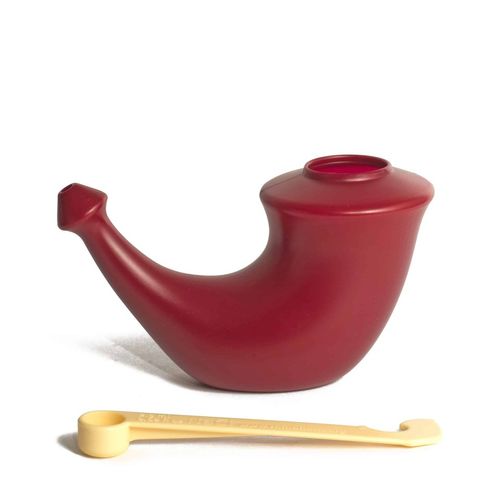Rhino Horn
Rhino Horn Nose rinse pot red
Rhino Horn Nose rinse pot red
Couldn't load pickup availability
Rhino Horn The rinsing jug is used to rinse the nose with salt water (isotonic saline).
- It helps in cases of nasal congestion due to cold, colds or allergies.
- It acts as a prevention and treatment for acute and chronic inflammations of the nasal cavities and sinuses.
- In people suffering from chronic allergic rhinitis (mainly due to allergy to pollen and dust), nasal irrigation will remove allergens and thus alleviate the problems.
- Nasal lavage is also suitable for excessive drying of the nasal mucosa.
- Regular nasal hygiene with lukewarm saline water increases the immunity of the nasal mucosa, which is then more resistant to bacterial and viral infections.
- It helps recovery after surgical procedures in the nose area.
Pot irrigation is very beneficial also for children who can handle this process from about 5 years of age (more handy and earlier). Of course, adult supervision is important here, and the child must also be able to blow up properly. Rinsing contributes to the release of the so-called back rhinitis and can prevent inflammation of the middle ear.
The rinsing of the nose is done by gravity, which minimizes unwanted water leakage into the middle ear.
The environment inside the nose is naturally salty and warm, so the rinsing of the nose uses slightly saline water , which is heated to approximately body temperature. Body fluids contain 0.9% salt, equivalent to 2.7 g of salt (1 scoop) per 3 dl of water in a Rhino Horn. If you are not sure about the quality of the tap water, we recommend boiling water.
Use:
Rinse the nose once a day according to the following procedure. In case of strong colds, sinusitis or an increased incidence of allergenic pollen in the air, nasal cleansing can be performed 2-4 times a day.
1 . Pour one measuring cup (= 2.7 g) of table salt (NaCl) into the jug. Do not use salt substitutes or flavored salt, etc. Fill the container with lukewarm water (approx. 37 ° C). You can shake the kettle or stir the water, eg with a measuring cup, to dissolve the salt more quickly.
2. Press the mouth of the jug against the nostril from the side - not from the front - and press lightly until the nostril is closed with the tip of the funnel. The solution should not leak through this nostril.
3. Breathe through your mouth. The mouth must be open. You cannot breathe through the nose during rinsing.
4. Lean forward slightly so that your head is above the sink, the chin should preferably point to the chest - it should not be pushed forward. Turn your head sideways so that you look sideways.
5. Tilt the teapot upwards and the water will flow spontaneously inside the nose and flow out through the second hole. When about half the contents of the teapot flow, lift the head and remove the container. Most of the water spills from the nose spontaneously, the rest can be squeezed out by lightly exhaling through the nose or gently blowing the nose.
6. Use the remaining half of the solution to flush through the other nostril.
7 . No water should remain in the nose and nasal cavities after the flushing is complete. This could cause problems especially in winter. Normally, it is sufficient to simply blow your nose to perfection.
All water must be out
However, if there is still some liquid inside, proceed as follows:
Bend forward so that the head is facing down. Turn the head aside and blow the upper hole. Turn your head face to the floor and blow your nose again. Repeat the procedure several times if necessary. Repeat for the other nostril. Then straighten and inhale and exhale several times through your nose.
Share


